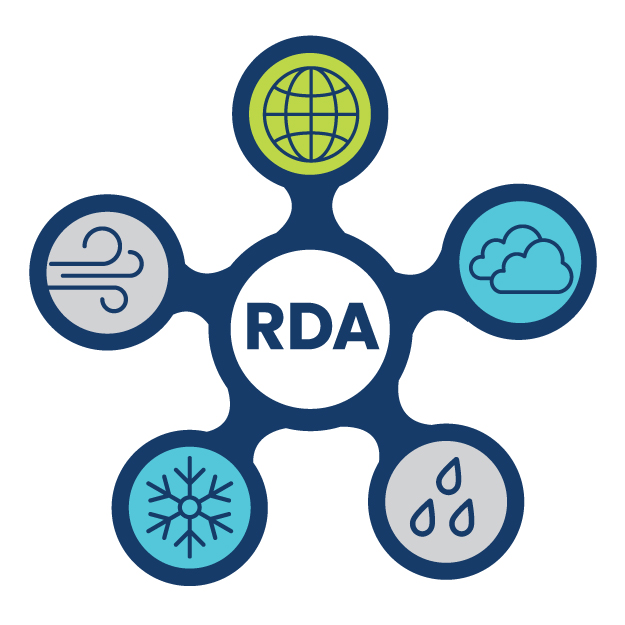
NOAA-CIRES-DOE Twentieth Century Reanalysis Version 3
d131003
| DOI: 10.5065/H93G-WS83
The Twentieth Century Reanalysis Project, produced by the Earth System Research Laboratory Physical Sciences Division from NOAA and the University of Colorado Cooperative Institute for Research in Environmental Sciences using resources from Department of Energy supercomputers, is an effort to produce a global reanalysis dataset spanning a portion of the nineteenth century and the entire twentieth century (1836 - 2015), assimilating only surface observations of synoptic pressure into an 80-member ensemble of estimates of the Earth system. Boundary conditions of pentad sea surface temperature and monthly sea ice concentration and time-varying solar, volcanic, and carbon dioxide radiative forcings are prescribed. Products include 3 and 6-hourly ensemble mean and spread analysis fields and 6-hourly ensemble mean and spread forecast (first guess) fields on a global Gaussian T254 grid. Fields are accessible in yearly time series (1 file per parameter).
The NOAA-CIRES-DOE Twentieth Century Reanalysis Version 3 uses the NCEP Global Forecast Model that was operational in autumn 2017, with differences as described in (Slivinski et al. 2019). Sea ice boundary conditions are specified from HadISST 2.3 (Slivinski et al. 2019). Sea surface temperature fields prior to 1981 are prescribed from the 8-member ensemble of pentad Simple Ocean Data Assimilation with sparse input (SODAsi.3, Giese et al. 2016) and from the 8-member ensemble of pentad HadISST 2.2 for 1981 to 2015. Observations from ISPD version 4.7 are assimilated using an ensemble Kalman filter.
The Twentieth Century Reanalysis Project version 3 used resources of the National Energy Research Scientific Computing Center managed by Lawrence Berkeley National Laboratory, which is supported by the Office of Science of the U.S. Department of Energy under Contract No. DE-AC02-05CH11231 and used resources of NOAA's Remote Deployed High Performance Computing Systems. Version 3 is a contribution to the international Atmospheric Circulation Reconstructions over the Earth initiative. Support for the Twentieth Century Reanalysis Project is provided by the Physical Sciences Division of the NOAA Earth System Research Laboratory, the U.S. Department of Energy Office of Science (BER), and the NOAA Climate Program Office MAPP program.
Papers using the NOAA-CIRES-DOE Twentieth Century Reanalysis Project version 3 dataset are requested to include the following text in their acknowledgements: "Support for the Twentieth Century Reanalysis Project version 3 dataset is provided by the U.S. Department of Energy, Office of Science Biological and Environmental Research (BER), by the National Oceanic and Atmospheric Administration Climate Program Office, and by the NOAA Physical Sciences Laboratory."
| Accumulative Convective Precipitation | Air Temperature | Atmospheric Ozone | Cloud Base Height |
| Cloud Fraction | Cloud Precipitable Water | Convective Available Potential Energy (cape) | Evapotranspiration |
| Freezing Rain | Geopotential Height | Heat Flux | Humidity |
| Hydrostatic Pressure | Ice Depth/Thickness | Ice Pellets | Latent Heat Flux |
| Maximum/Minimum Temperature | Planetary Boundary Layer Height | Potential Temperature | Potential Vorticity |
| Precipitation Amount | Precipitation Rate | Radiative Flux | Rain |
| Relative Humidity | Runoff | Sea Level Pressure | Snow |
| Snow Cover | Snow Depth | Snow Water Equivalent | Specific Humidity |
| Sublimation | Surface Roughness | Upper Air Temperature | U/V Wind Components |
| U/V Wind Components | Vegetation Cover | Vertical Wind Shear | Vertical Wind Velocity/Speed |
Latitude Range: Southernmost=89.463S Northernmost=89.463N Detailed coverage information Detailed coverage information 0.703° x 0.702° from 0E to 359.297E and 89.463N to 89.463S (512 x 256 Longitude/Latitude)
 This work is licensed under a Creative Commons Attribution 4.0 International License.
This work is licensed under a Creative Commons Attribution 4.0 International License.